The World Of Rexalia - Rexals
Preface
This document is simply for fun. It outlines what I assume Rexal anatomy and biology looks like. It is, by no means, 100% scientifically accurate. Often when something does not make sense, it operates by the rule of cool or simply "It's magic."
Rexals, even though I adore realism, are still magical creatures, and a certain amount of make-believe will always be present. Especially when it comes to things like "How can they switch between biped and quadruped?" Let's just have fun and pretend we are Rexal biologists in a world where all of this is possible. ;)
Anatomy

Taxonomic Classification:Species Name: RexalsCommon Names:Rex, Rexes Physical Characteristics:
Life Cycle:
|
Rex are massive dragons. They are able to walk on all fours or on their hindlegs, straightening their backs out. However, they are much faster running on all fours and most individuals will choose to do so when they are traveling [More on social norms in the social structure section].
They are able to swim and hold their breaths for long amounts of time, withstand high pressures and communicate via telepathy, making them able to explore even the deepest of seas.
Similar to monotremes, rexals are warm-blooded mammals that lay eggs. However, unlike monotremes, rexals do not produce milk and are capable of consuming solid food immediately upon hatching.
Rexals exhibit considerable variation in terms of their height, size, and weight, with these traits being largely determined by genetic factors. For the purposes of this document, the average rexal individual will be described.
Skeleton
Rexals exhibit a front-heavy body structure, with their front limbs bearing the majority of their body weight during quadrupedal locomotion. However, during bipedal movement, rexals shift their weight to their hind limbs, similar to the stance of a human. The rexal spine is capable of both straightening and curving, depending on the rexal's stance and movement pattern.
The rexal skull is elongated and bears a resemblance to a hybrid between canines and the Hydrurga species. Rexal pups are born with a shorter snout, which elongates as the rexal matures and develops their second, more robust set of adult teeth. The baby teeth of rexal pups are sharper and smaller than their adult counterparts.
Respiratory System
Rexals possess two large lungs that are divided into lobes, allowing for efficient gas exchange and oxygenation of the blood. Despite their relatively large lung capacity, rexals are not equipped to engage in prolonged underwater diving, with a maximum breath-holding capacity of approximately fifteen minutes before requiring replenishment of oxygen in their bloodstream.
However, rexals are capable of supplementing their oxygen supply through the practice of magic, which enables them to extract oxygen from the surrounding water. This technique requires intense concentration and significant training to perform effectively, allowing rexals to extend their underwater dive times with sustained practice.
Mouth & Digestive System
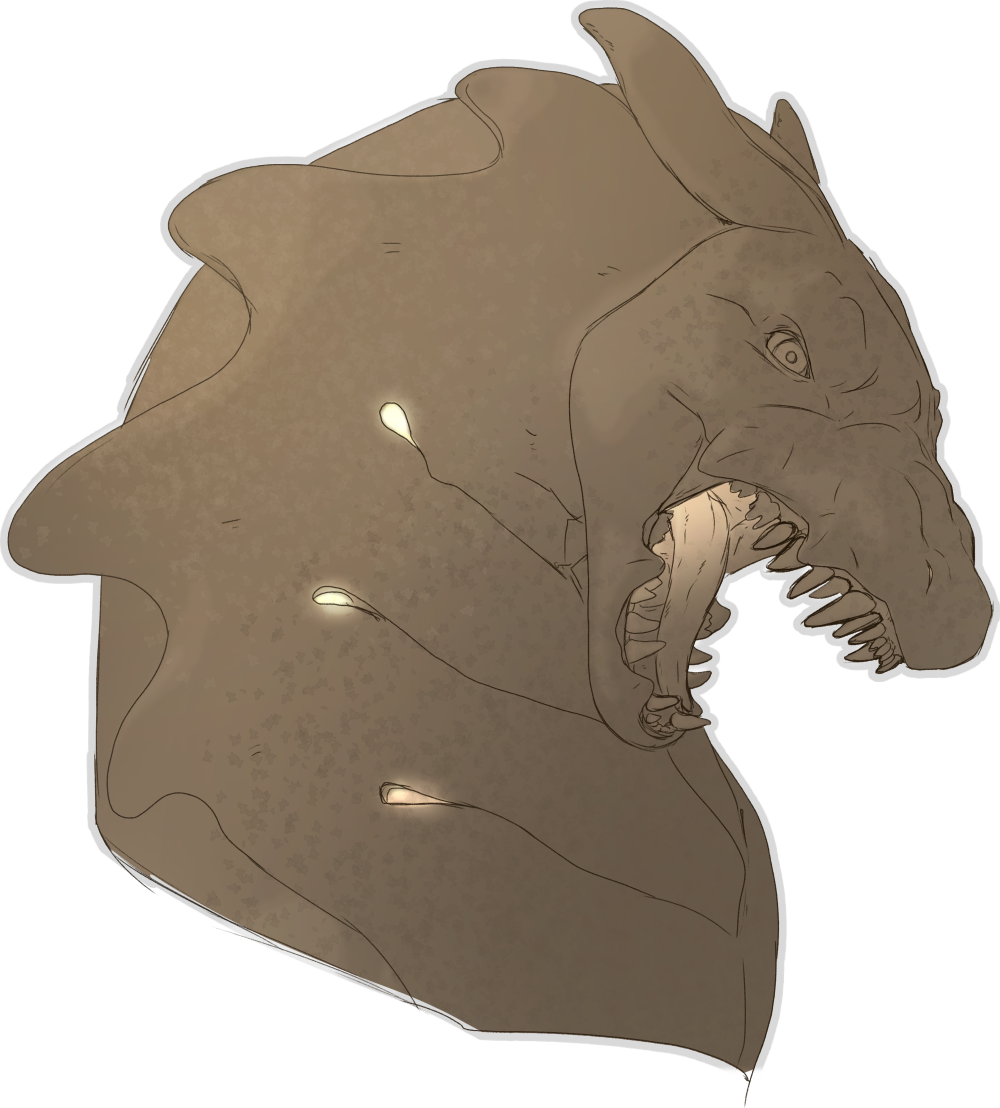 Rexal dentition bears a striking resemblance to that of the Hydrurga species, featuring sharp, elongated canines that operate through a scissor mechanism similar to that found in Canidae. The lower canine tooth of rexals crosses in front of the upper canine, amplifying their biting power. The incisors of rexals exhibit a pointed and elongated morphology, distinguishing them from the remaining teeth, which are shorter and less pointed. Rexal premolars are similar in appearance to those of canines, although they are more rounded and resemble the shape of those found in crocodiles. The molars of rexals, however, are distinct and exhibit a hook-like morphology with three prominent tips, similar to those found in leopard seals.
Rexal dentition bears a striking resemblance to that of the Hydrurga species, featuring sharp, elongated canines that operate through a scissor mechanism similar to that found in Canidae. The lower canine tooth of rexals crosses in front of the upper canine, amplifying their biting power. The incisors of rexals exhibit a pointed and elongated morphology, distinguishing them from the remaining teeth, which are shorter and less pointed. Rexal premolars are similar in appearance to those of canines, although they are more rounded and resemble the shape of those found in crocodiles. The molars of rexals, however, are distinct and exhibit a hook-like morphology with three prominent tips, similar to those found in leopard seals.
Rexals possess buccal flaps in their mouths, a feature that enables them to open their jaws to a remarkable 60-degree angle, surpassing the maximum jaw angle of 40 degrees observed in dogs. This anatomical adaptation enhances their ability to seize and manipulate prey effectively.
Rexals exhibit a slightly enhanced metabolic rate compared to humans, typically necessitating four meals per diurnal cycle. During intervals between meals, it is not uncommon for an individual to partake in intermittent snacking.
Muscles & Circulatory System
Rexals possess a robust musculature with a particular emphasis on their upper body and chest region, facilitating efficient long-distance travel at a slow pace. The pectoral and supracoracoideus muscles of rexals are notably pronounced, contributing to the rexal's overall strength and endurance.
In terms of jaw musculature, rexals exhibit a similar anatomical structure to mammals, albeit with distinct differences that are more extensively discussed in the dedicated Mouth section above.
Blood
The color of rexal blood typically ranges from red to nearly black, with individual variation in hue. However, when the rexal's magical abilities are engaged, their blood will emit a luminous glow that corresponds to the color of their personal magic.
In the event of an injury sustained during active magical engagement, blood escaping from the body will continue to emit a glowing aura that persists for several minutes. This phenomenon occurs as the severed blood is no longer directly connected to the rexal's central body core, allowing the magical energy to disperse into the surrounding environment. The luminosity of the blood eventually dissipates as the magical energy naturally deteriorates or diffuses into the atmosphere.
Locomotion
Rexals have the unique capability of transitioning effortlessly between two distinct modes of locomotion.
Biped
Rexals exhibit the ability to move bipedally by raising one foot at a time, with a gait pattern that is similar to that of humans. However, unlike humans, rexals distribute their body weight predominantly onto their toes while walking.
When standing, they often rest on their full feet, a unique characteristic that enables them to sustain a bipedal stance for extended periods with relative comfort. Additionally, rexals are capable of squatting down by flexing their legs, which optimally distributes their weight while resting.
Although rexals typically prefer quadrupedal movement, they are capable of adopting bipedal locomotion as their primary mode of movement if given sufficient rest.
Quadruped
Rexals are quadrupedal beings that prefer to ambulate on all four limbs for extended periods of travel. Their method of locomotion is similar to that of bears, with each foot moving in a mirrored pattern to the opposite end. Given their relatively large body mass, rexals are not capable of sustained sprinting for extended periods. However, they exhibit impressive agility and speed when needed, propelling themselves forward by pushing off the ground with their hindlimbs.
When walking, the full palm of their hands and toes touch the ground, facilitating their quadrupedal movement. 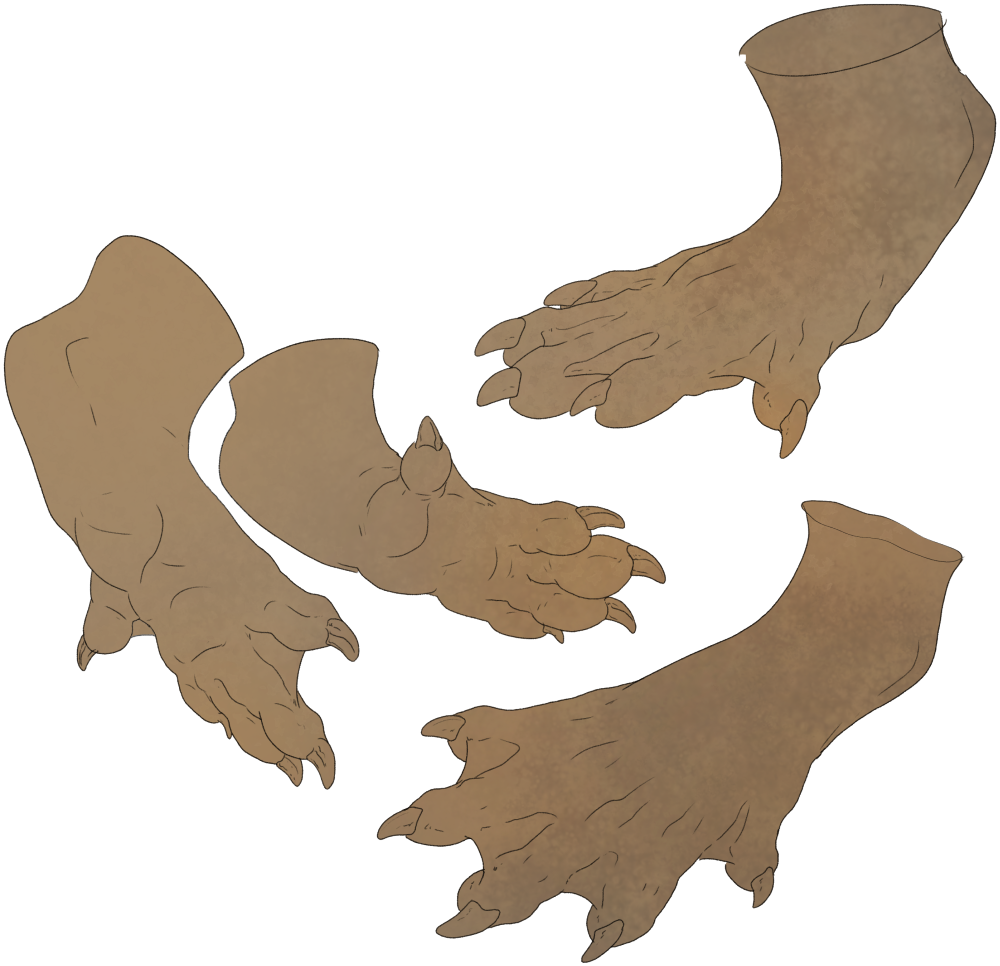
Backfeet
As depicted in the image located to the right ➡️
The structure of Rexal's hind feet bears a striking resemblance to that of rats, exhibiting notable similarities. One notable feature is the presence of an opposable thumb, which grants Rexal the ability to grasp and manipulate objects with dexterity.
Hands
Rexal forelimbs feature heavily padded hands that possess a reduced level of manual dexterity compared to human hands. Despite this, rexals are still capable of executing a range of manual tasks with their hands, albeit with less precision than humans. It is not uncommon for rexals to utilize their magical abilities to supplement their manual capabilities, enabling them to perform tasks requiring a higher degree of dexterity.
The claws of rexals are generally round and blunt, resembling those of beavers, and are not intended for scratching or cutting. Instead, these blunt claws serve a primary function in digging and excavating. Although the natural sharpness of rexal claws is relatively low, they can be sharpened intentionally by the rexal to enhance their functional utility.
Physical Characteristics
Size
The shoulder height of adult Rexals when standing relaxed on all four feet ranges from 5 feet 6 inches to 9 feet 5 inches. The average size, however, is approximately 7 feet 7 inches, with rare occurrences of heights falling below 6 feet or exceeding 8 feet 5 inches.
The mass of rexals displays substantial diversity. On average, rexals possess a musculature-to-fat ratio of 50:50. Nevertheless, this ratio can fluctuate significantly due to the species' propensity for accumulating adipose tissue, which is attributed to their affinity for spending prolonged periods in icy waters. While rexals exhibit a comparable lifestyle to seals, their anatomical structure is more adaptable to terrestrial environments with a moderate preference for aquatic habitats.
Ultimately, the weight of a rexal is subject to considerable individual variation, and a broad spectrum of body shapes and forms is not uncommon in this species.
Coats
The coat of rexals is typically categorized into two main types, armored or furred, which are solely determined by genetics and inherited from parents or grandparents. However, occasional mutations may occur, leading to the production of armored offspring from furred parents, although such phenomena are relatively infrequent.
Despite the significant differences between these coat types, the underlying factors contributing to their evolution remain unclear. The mechanisms that drive the development of an armored or furred coat in rexals remain an enigma, representing an area of active inquiry and exploration in the scientific community of the dome.
Armored
Armored coats are characterized by the presence of soft to hard scales and plates. These scales are pliable enough to allow for a full range of motion, yet robust and durable, affording rexals superior protection against injuries. As a result, rexals possessing armored coats are often sought after for jobs that require additional protection.
However, this unique adaptation comes with a tradeoff. Rexals with armored coats have a harder time regulating their body temperature compared to their furred counterparts, who have natural insulation in the form of air pockets in their fur. This limitation is especially pronounced while engaging in deep-sea exploration, where the frigid temperatures of the ocean pose significant challenges. Unlike whales, which possess lots of blubber for insulation, armored rexals lack such thick thermal protection, making them susceptible to hypothermia and other cold-related complications.
Think of armored rexal scales as the plates of a pangolin.
Furred
Furred rexals exhibit a remarkably dense coat of fur that is relatively short in length. The texture of their fur is reminiscent of that seen in leopard seals, exhibiting a soft and velvet-like feel in certain areas, while overall, it is coarser and akin to horse hair. Notably, their arms and legs bear longer fur, which is the extent of longer hair typically observed in rexals. The fur on the remainder of their body lies flat against the skin and is incredibly short, enabling the clear delineation of underlying musculature and body contour.
Tail
Rexal tails possess a remarkable combination of strength and flexibility, enabling them to propel themselves through water with unparalleled efficiency. The tails are typically held in a soft 'S' shape, strategically positioned just above the ground, bestowing streamlined form, a critical prerequisite for efficient navigation through water and for excellent balance on land.
The shape of rexal tails bears an unmistakable resemblance to those observed in otters, albeit longer and more prehensile. This unique characteristic imparts rexals unrivaled dexterity and manipulation abilities, enabling them to grasp objects with remarkable precision, such as rocks or coral. The prehensile nature of their tails is particularly advantageous in their aquatic habitat, allowing them to secure food, shelter, and navigate through tight spaces with remarkable ease.
Throat Armor
The most salient morphological characteristic of rexals, the armor plate situated on the ventral surface of their throats, is primarily composed of keratin, a fibrous protein that provides both flexibility and strength.
The pliant nature of this structure allows for unimpeded movement while still affording ample protection to the vulnerable throat region.
While the functional significance of this feature remains unclear in contemporary rexals, it is believed to be a vestigial remnant of early developmental stages. However, the presence of six prominent apertures directly linked to the rexal's central body core located beneath this armor plate suggests that this feature may serve a crucial protective function for these vital anatomical structures.
Apertures
Rexals possess a unique vent system that directly connects to their circulatory system, facilitating the release of excess magical energy into the surrounding atmosphere. This process occurs spontaneously without direct conscious control from the rexal, although it can be regulated through training.
The interior structure of these openings comprises a shallow depression containing glands that act as a selective barrier between the circulatory system and the external environment, allowing the passage of magical particles while retaining other cellular components within the body. During periods of heightened magical activity, these apertures emit a glow that corresponds to the rexal's individual coloration, although in a quiescent state, they typically appear in the same hue as the rexall's skin tone.
These orifices are situated on specific areas of the rexal's anatomy, including six on the throat armor, four on each front arm, and four on the tail, serving as critical sites for the shedding of excess magical energy.
Horn Ears
The auditory organs of rexals resemble horns in appearance, composed of hollow structures that capture and direct sound vibrations to their inner ear. The internal architecture of these organs includes soft tissue that is replete with perforations, facilitating the capture and concentration of sound waves.
These horns can be flexibly manipulated at their base, enabling them to wiggle in response to the movements of the rexal or for them to move at will.
While gentle compression of these organs does not cause discomfort to the rexal, severe injury to these structures can lead to complete hearing loss. However, partial preservation of the horn ears can still enable the perception of sounds, albeit with reduced acuity.
| Here we see a detailed view of the ears, showcasing their appearance from all angles, providing a comprehensive understanding of their anatomical features. |
 |
Senses
Vision
The visual system of rexals exhibits striking similarities to that of humans, with four distinct types of photopigments, including red, green, and blue receptors. Notably, the fourth receptor is specifically adapted to detect magical stimuli, conferring upon rexals a unique perceptual ability that is not available to other animal species.
In contrast to non-rexal creatures, who are unable to directly perceive magic, rexals possess the capacity to sense and respond to magical influences in their environment. This allows them to detect elusive magical phenomena such as smoke, projections, and the iridescent reflections of surfaces illuminated by magical energy, which remain invisible to other inhabitants of the planet.
Rexals possess nictitating membranes, which serve multiple functions such as facilitating underwater diving and removing ocular debris. These membranes also provide ocular protection and moisture retention while preserving visual acuity.
Hearing
Owing to their distinctive auditory organs, rexals exhibit a unique mode of sound perception that distinguishes them from other animals. While their hearing sensitivity is not extraordinary, it is exceptionally adept in both aerial and aquatic environments, enabling them to detect and interpret acoustic cues with remarkable accuracy. Studies suggest that the auditory processing mechanisms of rexals share certain similarities with avian species, further underscoring the distinctiveness of their hearing abilities.
For a detailed examination of the unique morphology and function of rexal ears, please refer to the dedicated section on Horn Ears.
Smell
Rexals possess a highly developed olfactory system, characterized by sensitive nasal structures and the capacity to close their nostrils for underwater exploration. The olfactory receptors of rexals share a degree of similarity with those of grizzly bears, underscoring the efficacy of their sense of smell in detecting and discriminating different odors in their environment. This heightened olfactory sensitivity enables rexals to discern subtle cues related to prey and other ecological factors, facilitating their survival and success.
Taste
Rexals possess a similar taste sensory system as humans. The tongue is the primary organ responsible for detecting and transmitting taste signals to the brain. The tongue is covered by numerous papillae, each containing taste buds that respond to different types of taste stimuli. The five basic tastes that rexals can recognize are sweet, sour, salty, bitter, and umami (savory).
The length of a rexal's tongue is proportional to the length of its muzzle, with the tongue extending to approximately half of the muzzle's length. Despite their reptilian appearance, rexals lack a Jacobson's organ and are unable to employ their tongues for olfactory purposes.
Rexal tongues exhibit a degree of genetic variability, which determines whether they are forked or non-forked. While some individuals possess a forked tongue, others may have a non-forked one. The morphology of the tongue is similar to that of certain reptiles, such as skinks. The thinning of the tongue towards the end is a characteristic that is shared by both forked and non-forked tongues in rexals, and this morphology aids in the gathering and identification of sensory information.
Touch
Overall, rexals have the same sense of touch as humans. However, their sensory abilities extend beyond the conventional sense of touch, with specialized adaptations enabling them to detect vibrations in both water and air. These adaptations include their highly sensitive muzzle and horn ears, conferring them a significant advantage in identifying movements and potential prey.
The mechanoreceptors present in rexal muzzles and horn ears are incredibly sensitive, allowing them to detect even the slightest vibrations in their environment. These adaptations are critical for survival in their aquatic habitat, enabling them to navigate through water with unparalleled precision and detect the presence of prey at great distances.
Other
Temperature Regulation
Rexals exhibit endothermy, the ability to maintain their body temperature through internal metabolic processes like mammals. However, owing to their exceptional magical aptitude, they possess the capability to thermoregulate by either increasing or decreasing their body temperature with sufficient practice. This adaptive trait is particularly advantageous when navigating harsh environments and engaging in deep-sea exploration, such as the Posian trench.
Magic Sensitivity
Naturally, rexals possess unique sensory adaptations that enable them to process and respond to magic in ways unparalleled by any other life form on the planet.
The eyes of rexals are particularly adept at detecting magic, possessing specialized receptors that are absent in other animals. This unique ability enables them to perceive the usage of magic, rendering halos, magical smoke, and the light emanating from magic imperceptible to other creatures. This characteristic is particularly advantageous during deep-sea hunting, allowing rexals to illuminate their surroundings without alerting potential prey.
Moreover, rexals possess the remarkable ability to train themselves to detect strong sources of magic. Although this skill requires some practice, it is not particularly challenging to acquire, given the innate magical abilities of the species.
Communication
Rexals employ a language system that is primarily based on Latin, owing to its ease of understanding and the thematic context of their setting. Unlike humans, who mainly utilize their lips and tongue to produce speech, rexals generate sounds using their throat and tongue, which resembles the vocalization patterns observed in birds.
Rexal vocalizations bear resemblance to human speech, albeit with a marginally lower frequency.
Spoken words form the most common mode of communication among rexals. However, they also possess a unique ability to communicate telepathically, a learned skill that nearly every rexal acquires over the course of their life. This ability to communicate telepathically is particularly advantageous during deep-sea diving expeditions. However, for telepathy to be effective, the receiving rexal must provide their consent for transmission and utilize their own magical abilities to receive the message.
Rexals can also communicate with animals using telepathy, albeit with certain limitations. The animal's comprehension of detailed concepts is limited, and they primarily understand emotions and feelings that a rexal may invoke in them using their magical powers.
Instincts
Rexals possess a set of inherent instincts that bear remarkable resemblance to those present in humans, namely creativity, reflection, activity, love, and hunger. Nevertheless, akin to humans, they have an innate capacity for logical reasoning, which profoundly influences their responses and subsequent actions in a given circumstance.
Intelligence and Cognition
Rexals are as, if not maybe even more, intelligent than humans.
Rexals have cognitive abilities and a mental capacity that allows individuals to learn, understand, reason, and think abstractly. It includes the ability to solve problems, make decisions, perceive and interpret information, and communicate effectively. Their intelligence is very complex and involves various cognitive processes such as memory, attention, perception, language, and reasoning. It is also influenced by factors such as genetics, environment, education, and experience. Overall, their intelligence is a multifaceted construct that enables individuals to adapt to their environment, learn from their experiences, and achieve their goals.
This allow rexals to shape themselves and their world around them in ways that no other animal is capable of.
Birth and Development
Their eggs are characterized by hard, marble-like shells, which gradually thin out as the hatching date of the pups approaches. The gestation period for a Rexal egg to hatch is typically around four months.The development of Rexal eggs is independent of temperature influence, as genetic traits are established at the moment of conception. While the incubation of Rexal eggs necessitates warm conditions for optimal development, they have the ability to enter a state of dormancy, effectively pausing the developmental process until they are re-exposed to a warm environment.
The thick and durable nature of the eggshells provides critical protection to the developing fetus, enabling it to mature safely and efficiently. Upon hatching, the young ones, referred to as pups, receive parental care and rearing, similar to humans, reflecting the remarkable social and nurturing behavior exhibited by this species.
Remarkably, the first thirty years of a rexal's life are considered the equivalent of human minors, underscoring the extended developmental period observed in these creatures. Such a prolonged developmental period enables rexals to acquire a range of skills and knowledge, as well as navigate their complex social structures with greater efficiency and precision.
Hunting, Gathering and Farming
Rexals exhibit proficiency in all three modes of obtaining sustenance. While agriculture is the most prevalent means of procuring food, encompassing livestock husbandry for meat, rexals are also adept hunters, utilizing their innate abilities.
Given their limited sprinting capacity, rexals frequently employ stalking tactics to surprise prey. Alternatively, they employ the time-honored strategy of trailing the quarry until it succumbs to exhaustion, akin to the hunting practices of early human civilizations. Rexals possess remarkable endurance, which they leverage for this purpose.
Rexals rely primarily on their dentition to subdue and eliminate prey, utilizing their manual extremities for stabilization or restraint. Despite their aptitude for using conventional tools available in their temporal realm, rexals possess a natural inclination towards this fighting and killing modality, which is second nature to them.
Gathering is a natural inclination for rexals, who rely on their sensory acumen to locate edible flora. However, it is noteworthy that rexals do not frequently engage in this practice.
Magic
 |
| A great example on how magic flows out of the apertures by @simplybones |
As rexes learn more spells, their innate magic grows within them. Mastery comes with practice, and no rex can fully utilize their magic from birth. There are various types of magic, each with its unique applications. For instance, rexes who enjoy exploration may learn spells to traverse different terrains, like warming or cooling spells, or resistance to harsh rocks. Others with artistic inclinations may learn spells for cooking or aiding crop growth. How a rex chooses to use their magic is entirely up to them!
One unique feature of rexes is that their magic is always visible as a faint glow inside their mouths.
Halos:
Halos are a visible manifestation of a rex's magical power. It is within the rex's control to make their halo visible or not. Typically, a rex's halo only becomes visible when they are actively using magic. However, in certain situations, a rex may use their halo as a light source in dark environments or to indicate their status, such as a show of authority or power.
There are three kinds of halos, seen here:
|
The title "regal" is given to every rex, regardless of their magical abilities, who possesses the level 1 Halo. |

The title "blessed" is given to rexes who have achieved a level 2 Halo, indicating that they have successfully leveled up their magical abilities once. |
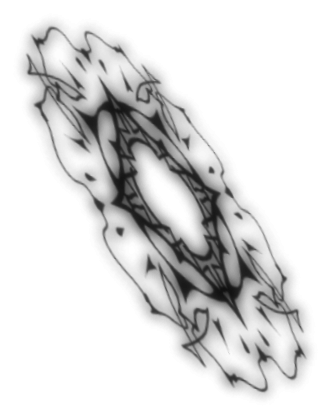
The title "divine" is bestowed upon rexes who have attained a level 3 Halo, indicating that they have reached the pinnacle of magical mastery. This level of halo allows for customization and alteration of its form, reflecting the rex's exceptional control over their magic. |
Manifestation
Magic in rexals is always manifested in the specific magic color they were born with. When magic is visible outside of the body, it takes the form of colored smoke that dissolves into the air. Regardless of the form it takes, magic always retains the color associated with the rexal's inherent magical aura.
Magic Restrictions
The efficacy of common rexal magic is not particularly robust, as its function is primarily utilitarian in nature, akin to the use of hands in everyday life. Its application is generally limited to facilitating the growth of plants or transmitting positive emotional states to animals. Nevertheless, with practice, rexals can develop their magical abilities to achieve more impressive feats. For instance, they can manipulate their magical smoke to create lifelike images and projections, which is often employed by street performers to enhance their storytelling.
Additional examples of rexal magic include warming and cooling spells, as well as levitation spells, though the latter is restricted by the weight of the object being lifted. Notably, higher ranking rex possess more potent magical abilities, enabling them to lift heavier objects, expedite plant growth, and extend their telepathic reach.
Core Principles of Magic
The fundamental principle of rexal magic is that it allows for manipulation, but not creation. Even the elders, the most powerful beings in the rexal world, are not capable of creating or willing things into existence out of thin air. Their magical abilities are limited to manipulating or moving objects within the confines of what is physically possible, and they do not possess the power to create something from nothing. Rexals are unable to add magic to objects to make them inherently magical, and their magic is not a deus ex machina that can solve all problems.
Rexals are also unable to manipulate other rexals with their magic. They cannot force anyone to do their bidding or cast spells on others. However, they can use their magic to perform tasks that could also be done with their hands, such as lifting objects.
Some types of magic allow for coaxing of plants or animals. For example, a rexal with plant magic may be able to help a plant grow healthier by being more in tune with farming practices, but they cannot make a flower bloom instantly. This type of magic also enables rexals to be more attuned to their environment, which can be useful for casting spells such as warming or cooling spells.
Divine magic is generally stronger, allowing for greater lifting capacity, heightened sensitivity to surroundings, and faster execution of magical tasks. For example, a divine rexal's cooling spell may freeze its target if willed with sufficient strength.
Magic Sight and Impression
Magic is intangible and cannot be seen or felt by other creatures unless it is used to directly affect them. For example, lifting a deer in the air using magic would make the deer feel the effect of the magic, but not the magic itself. The halo is an exception, as the owner of the halo can make it tangible with practice, allowing it to be touched. However, if another creature were to sit on the halo, it would feel like sitting on thin air to them, as the halo's tangibility is limited to its owner's control.
Extent of magical Manipulation of Objects
The extent of manipulation with magic is limited by the physical properties of the object being manipulated. For example, wood cannot be transformed into the leg of a chair using magic, but it can be cut or whittled if a rexal is able to hold a knife with their magic. The hardness or malleability of an object determines how it can be manipulated with magic. For instance, a sack full of sand can be pressed into a shape using magic, similar to how it would be done with hands.
Questions and Answers
Can Rexals transform?
Rexals do not possess the ability to undergo physical transformations. However, it is postulated that elders, if they choose to, may manifest in an altered form to Rex, albeit through illusionary means rather than literal transformation.
Can rexals exert control over other rex to compel them to comply with their desires?
No, rexals do not have the ability to force or control other rex or animals. Consent is a fundamental requirement, and actions or behaviors that violate the principle of consent are not possible.
Can rexals control the weather?
No, rexals do not possess the ability to control the weather. The capability to manipulate weather conditions is attributed solely to the elders, who wield authoritative control over the weather within the dome. It should be noted that elder rexals exhibit significantly amplified magical capabilities compared to regular rexals.
Is there a sac beneath a rexal's neck plates where magic is stored?
No, there is no sac under a rexal's neck plates that serves as a storage for magic. Instead, the magic is distributed through the rexal's main circulatory system, carried by the blood from the heart to the head where the halo is located. The halo itself acts as an external storage for magic, and it grows in size as a rexal levels up. Divine rexals are believed to have a larger magical storage capacity in their halo, which allows them to access and utilize magic more readily in urgent situations.
Is magic condensed into a physical form within the rexal's body, akin to blood, or is it immaterial?
The nature of magic within rexals is a combination of both material and immaterial aspects. Magic is present in the blood of a rexal, but it remains in a liquid form as long as it remains within the rexal's body, if it does not come into contact with air or water. It can be likened to molecules or substances within the blood that have magical properties. However, if the magic-infused blood is exposed to air or water, it will dissolve and lose its physical form.
Do rexals utilize magic to hatch from a stone egg?
No, rexals do not use magic to hatch from a stone egg. The hatching process is not driven by magical means, but rather by the physical development of the rexal inside the egg. As the rexal grows, the shell of the egg gradually thins out, making it easier for the rexal to break through. When the shell has sufficiently thinned and the rexal is ready to hatch, it can use physical force, such as prying or exerting pressure, to crack open the egg and emerge. The hatching process of rexals is not associated with the use of magic, and baby rexals do not possess significant magical abilities at such an early stage of development.
Do rexals hatch from the egg with a halo or glowing apertures, or are the apertures flesh-colored?
The appearance of a halo or glowing apertures upon hatching from the egg varies among individual rexals. Some rexals may exhibit a halo or glowing apertures immediately upon hatching, which could be indicative of their inherent magical abilities and potential. However, other rexals may not display a halo or glowing apertures until later in their development, sometimes even after a year of life. The presence or absence of a halo or glowing apertures upon hatching is individualistic and does not necessarily determine a rexal's future magical prowess. It is observed that different rexals may exhibit different levels of magical ability and aptitude from the time of their birth.
Can rexals spew fire?
No, rexals do not possess the ability to spew fire. However, divine rexals may have the capability to increase the temperature of an inflammable item, which could potentially result in setting it on fire. This ability is limited to manipulating heat and is not considered as spewing fire from their own bodies. It should be noted that not all rexals have this ability, and it is unique to certain divine rexals with higher levels of magical abilities.
Can Rexals levitate themselves to fly if they do not grow wings?
No, Rexals do not have the ability to levitate themselves to fly. Levitation is akin to picking oneself up, which is not possible. Although elders, who possess higher magical capabilities, technically have the ability to levitate, they choose not to use it.
How do Rex illusions work? Is there a size or complexity limit?
Rex illusions can be as complex as the Rex wishes them to be, but it requires a lot of practice. There is no inherent size or complexity limit to Rex illusions, as they are limited only by the Rex's skill and control over their magical abilities.
What about other senses aside from sight being affected by illusions? Can a sound or smell or touch be part of an illusion?
Yes, with enough practice, Rex can create illusions that involve other senses aside from sight, such as smell and sound. However, touch is not possible as magic is still intangible. Rex may choose to overlay illusions over objects that other Rex can touch to create a more immersive illusion experience.
Can a Rex fool another Rex into believing they are in a whole different room or place?
Yes, with sufficient practice, a Rex can create illusions that deceive another Rex into believing they are in a completely different room or location. However, this is generally frowned upon and considered unethical behavior in the Rex community.
Telepathy, what's the range on that? Is it the same as a normal rexal's voice? Does it also increase as a rexal levels?
Telepathy works similarly to a rexal's voice in terms of range. It can reach about the same distance as a normal voice, and it may weaken the further away the recipient is. The range of telepathy does not necessarily increase with a rexal's level, but it does require practice to develop and refine the ability.
You mentioned telepathy had to be accepted by the rex trying to be contacted. How does this work, is it like a text message alert buzz in the mind? A nudge of thought they recognize?
Yes, when attempting telepathic communication, the rex initiating the contact sends a "nudge" or a subtle signal to the recipient. It's like a mental alert or a nudge of thought that the recipient may recognize. However, the recipient rex can choose to ignore or block the telepathic message if they wish, so communication through telepathy requires mutual consent and understanding. It's important for rexes to communicate beforehand and concentrate on each other to establish telepathic communication effectively.
Phasing through materials - is this a thing rex can do?
No, rexes are not capable of phasing through materials or manipulating objects in such a way. They do not possess the ability to walk through trees, walls, or objects like a piece of paper. Phasing, as a form of manipulation, is beyond their capabilities. They cannot phase themselves or other objects through materials. The only exception to this is the elders, who may possess limited phasing abilities, but even for them, it is very restricted.
The Elders
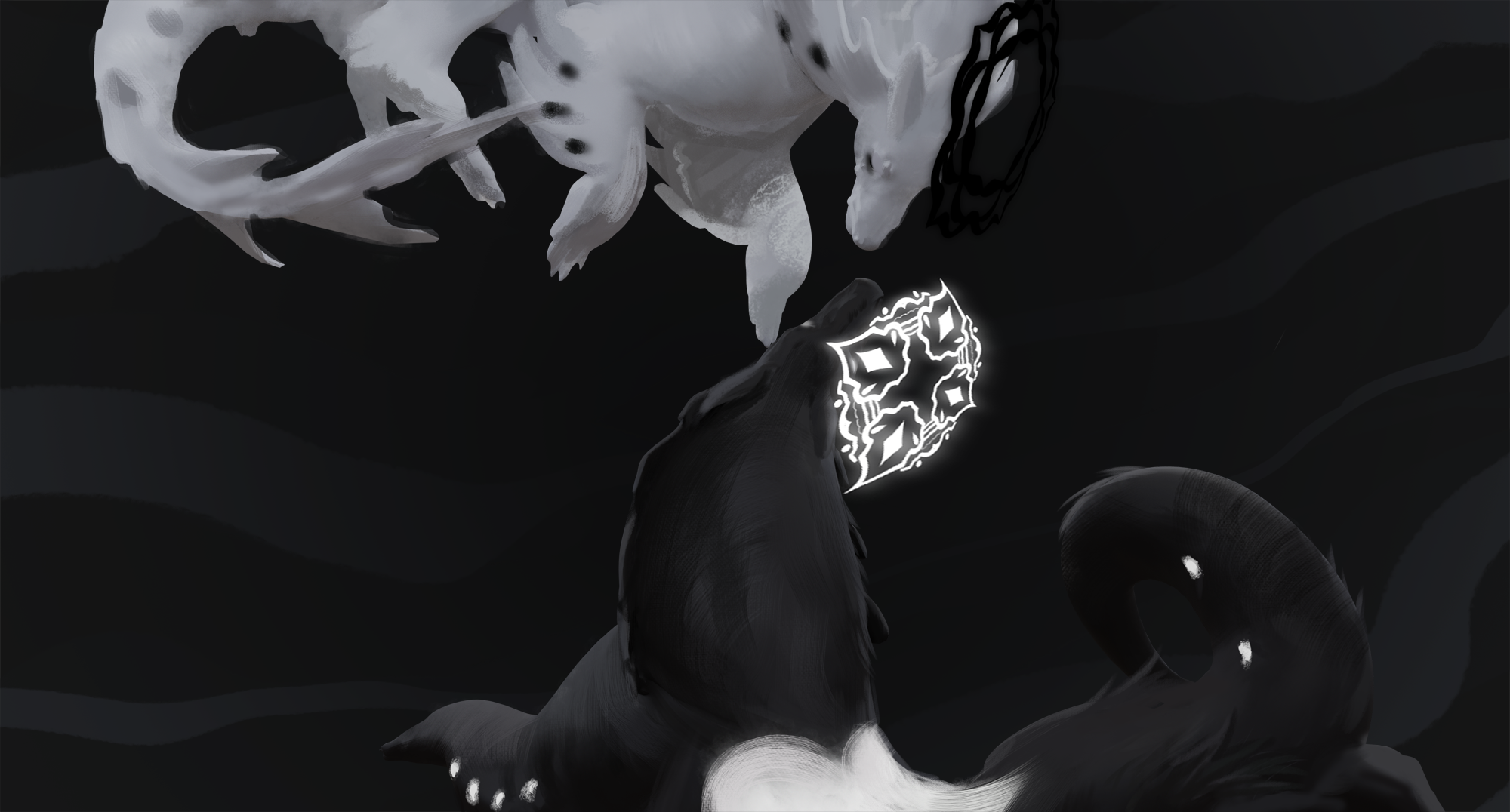
Look At The Elders!
Deep beneath the dome lies a temple constructed like a magical labyrinth that only the elders can navigate. Most of the time, the elders rest in hidden chambers within the temple.
These powerful beings possess magic abilities beyond any other and can control various elements even while sleeping. They have control over the weather, temperature, and the magical dome that surrounds their home. Additionally, they ensure that the dome's population remains limited by casting a spell that prevents rexals from laying eggs unless the spell is lifted for a specific period of time.
The elders seldom venture outside the labyrinth temple, except on special occasions. A rare exception is Canto, who cares for the Orbitas and magical eggs. Some elders can be spoken to under certain circumstances.
 |
 |
Elders are allowed to be used in your personal lore, however you cannot depict them in lore accurate prompts and events, such as your CoAC. We will not stop you from using elders as the parents of your rexal either, however, keep in mind that you can only depict them as such, in lore pieces if your rexal is a direct offspring from two or one of them. This is a reward for earning elder slots through gameplay (or otherwise).
They are, however, able to be used as mentors or friends, should you wish to include it in your personal lore. Their personality is able to be read in the info section of their import, should you be interested.
Elders are overall meant as the driving force of the group's lore and will be used by admins to convey the plot, events or used in certain group functions.
Basileus NPCs
Some rexals, owned by the group's founder/s, may be utilized to advance the plot, serve as story beats, or appear as characters in official stories. These characters do not strictly fall under the NPC status (which is intended for general use by anyone), nor the Elder status (which are specifically located in the dome). While these characters can be casually played and do not possess higher powers (such as the elders) or in-game advantages, they may still be portrayed as such in comics, story beats, or plot-driven quests.
Please note: Rexalia is primarily a lore-heavy, story-driven group, which means that the characters used in these stories belong to, are played by, and are managed by the higher admins.
The NPCs
 Look At The NPCs
Look At The NPCs
Rexalia is home to several well-known rexals who have gained somewhat of a celebrity status. They are often spotted in various locations across the world of Rexalia, and their stories can be found everywhere. For more information about these rexals and their whereabouts, it's recommended to check out their profiles.
Personal NPCs and You
Oftentimes, you may wish to create a family of rexals according to your own personal preferences. In such cases, you are at liberty to invent rexals specifically for this purpose. However, it is important to exercise caution, as any artworks that you have already created cannot be applied to a design acquired later. Any artworks that were created prior to the design's creation will not be considered for MP or rolled for activities, events, or similar purposes.
You have complete freedom to design these rexals in any way you wish, even if the designs are illegal. These rexals are intended solely to enrich the story and lore of your approved rexals.
Be wary, though! These cannot be played in the game, will bring no loot, won't be able to complete prompts, events and other parts of the game. They will also not be able to be put on any official lines/imports. References for them must be custom drawn.
Lifestages
Pups
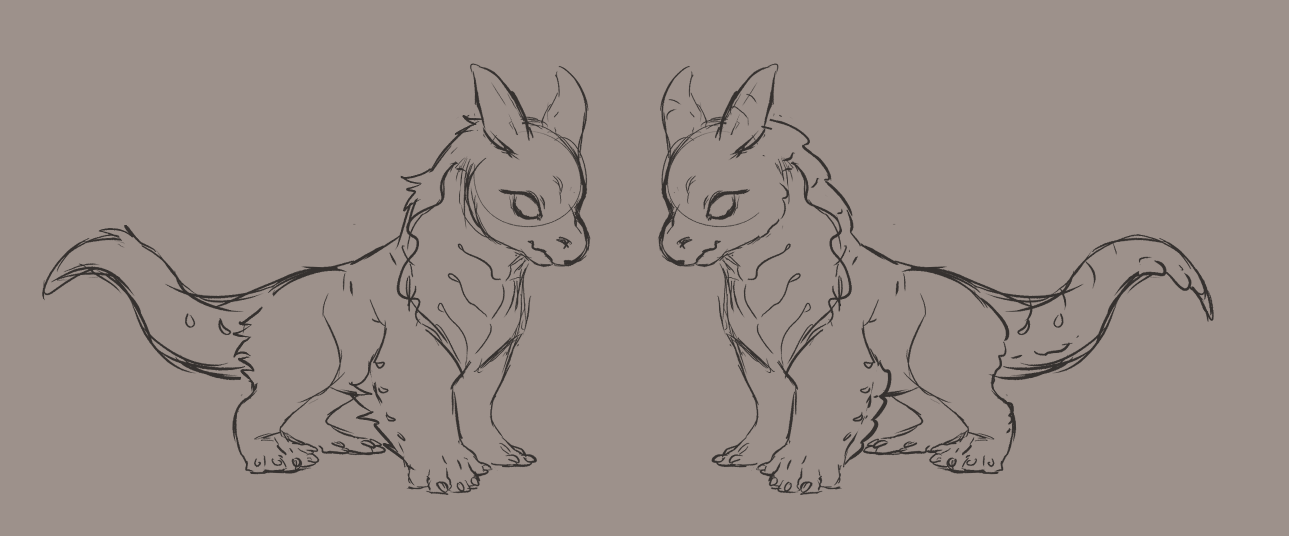
Young rex are called pups up until they absolved their Coming of Age Ceremony.
Young rexes, before they reach maturity, can be easily identified by their rounded side spines, which have not yet developed into the signature throat armor spines that adult rexes possess. These throat armor spines slowly develop as rexes grow and mature. In addition to the underdeveloped spines, young rexes have a different physical appearance compared to adult rexes. They generally have a chubbier build, shorter snouts and legs, bigger ears and eyes, and shorter tails. However, their tails are always longer than the entirety of their neck. These physical differences make young rexes ineligible for many of the tasks and responsibilities that adult rexes undertake in their society.
During this stage of development, young rexes typically stay with their parents for most of the day. They require the guidance and protection of their adult counterparts as they continue to grow and develop their physical traits. As they reach maturity, their physical appearance changes, and they acquire the distinct features of adult rexes, including the fully developed throat armor spines. This marks their transition into adulthood and makes them eligible for the tasks and responsibilities that come with it in their society.
Lineage-less Rexals
Sometimes rexals don't have parents or families from the start of their life. Especially those under Canto's care.
These eggs are directly made by the elders to supply the dome with a perfect stream of genetically diverse rexals. Their genetic footprint mostly consists of a mixture of the elders themselves, but never just two of them. Their creation is highly magical, making them truly parent-less in a way. These rexals get adopted by families in the dome or, sometimes, even grow up until they are adults with Canto, who will make sure they have a place to stay in his care until they are ready to leave.
In lore, it is a huge honor to be created in such a way and many families in the dome value such a child highly.
Of course, this is just group lore. If you have a rexal that has no lineage, you are free to make NPCs that are their real parents, give them siblings and or even ask other members if you can use their rex as their parents for your lore. It will just not be stated in their lineage.
The world of Rexalia
We Are Left...

Everyone knows, of course, that the Ancients bestowed the Elders upon us, gave them their great power and wisdom to guide and lead us. From the Ancients, the Elders were able to conjure our world between their combined claws, continuing on to molding and nurturing us as well.
For however great the power of the Elders, though, you would be wrong to assume it was simple - building a life never is. With only the blessings of the Ancients, dominion over the Dome and the fertile ground contained within, and their knowledge of the Old World, they set to the task of making our Everything out of Nothing. The Elders don't speak of it - and out of respect, many of us do not ask - but the process has spanned centuries, undoubtedly.
What do the Elders know of the Old World, you ask? Best not to trouble them with such trifles, let me tell you instead. Look around you - the size of the Dome is so perfectly attuned to our forms, the items we use on a daily basis, the little bits of ruins, the treasures of the deep, even -
The Fog Above
But as time passes, a subtle change occurs. The fog begins to dissipate, revealing a world that is both familiar and perplexing. Rexalia, once a realm of diverse landscapes and eras, now finds itself trapped in disjointed pockets of time.
But questions abound. How did the fog come to be? Did it engulf the planet all at once, or did it creep in gradually, consuming everything in its path? And why does the dome, their safe haven, lag behind in time, seemingly disconnected from the rest of Rexalia?
As the fog slowly clears, revealing glimpses of a world fragmented and frozen in time, the rexals are left to ponder the secrets that lie buried within the mist. What other mysteries lurk in the depths of Rexalia, waiting to be unveiled? Only time will tell as the fog lifts, revealing a world that is both hauntingly familiar and eerily perplexing.
On Rexal Religion
Religion is a bit of a misnomer within rexal society. The rex population doesn’t worship any one god or even a pantheon of gods, so much as they revere their ancestors, whom they refer to as the Ancients, the ones who came before them and made life possible for them.
Alas, not much is known about their origin, but it is said that their species had fled into the dome itself, heavily modified by magic of the Ancients to survive so deeply underwater. Many say that their ancestors had been huge magic-bearing dragons that could fly and bend the very land by their will. This is supported by the odd gigantic bones that were found deep in the Posian Trench, however, no one can be completely sure. It’s a tale commonly told to young school children, but factual supporting evidence on the matter is quite scarce. All rexal know the Dome was created by the Ancients, this is just an accepted fact. But when was it created? How? The answers to those seem to be lost to time. Still, this does not diminish the awe and respect that rexals hold for their ancient ancestors which they firmly believe they have descended from. They understand that the Elders were created by these ancient ancestors for the purpose of watching over and caring for the rexal species. It is why it such an honor for a rexal to have an Elder as parent, as it is the most direct connection rex have back to their revered Ancient anscestors.
Rexals do not have a concept of an afterlife. Life is all about the here and now, and they live life to the fullest in the present. There is no thought or planning for what is to come in an after life, because to rex, there simply isn’t one. When a rex dies, all parts of them are returned to the world. This belief is where you will often find older rex talking about aspects of their parents or siblings or even children they lost early being returned in part to another rexal. They hold the belief that all things are returned and recycled by the world, including such aspects as what a ‘soul’ may consist of. These pieces of what makes a rex a rex do not leave to go to some other world or plane, they are returned and reused to help make new rexal. They are used to carry on this proud species. Just as some rexal believe that they carry with them a piece of an Ancient, so too do they believe that when they pass, a piece of them may be carried on by another rex to come.
Ancestor worship – just as rex admire beauty in current times, so too do they believe that Ancients would have admired the same. Flowers are often gathered and burned as offerings to the Ancients, both at temples and in smaller shrines and local community gatherings. Artists often create pieces that they hope will be pleasing to the Ancients, be these vases, carved statues, murals or any other form of decoration. These pieces are often put on display for a time at local temples to not only be viewed and admired by the rex who gather here for socializing, but also as homage to the Ancients.
The World & Locations
Go to The World!NOTE: The locations page is currently still worked on. Thus, it will lead you to the front page. We will announce when it's all ready!
That page will include more about culture, animals and social norms.

